

How to use FF Chartwell. Primarily suitable for Adobe Creative Suite, FF Chartwell for print uses OpenType ligatures to transform strings of numbers automatically into charts.
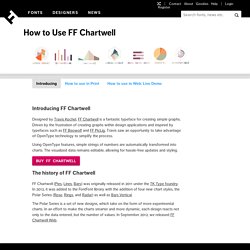
The data remains in a text box, allowing for easy updates and styling. It’s really simple to use; you just type a series of numbers like: ‘10+13+37+40’, turn on Stylistic Alternates or Stylistic Set 1 and a graph is automatically created. To help get you started using FF Chartwell we’ve created this video tutorial and here are some simple steps: ONE — Firstly always make sure the letter spacing is set to “0” (zero) TWO — Using the values 0-100, type the values, then use “+” to combine them into one chart.
Stripe: Payments for developers. About. The OpenVDB library comprises a hierarchical data structure and a suite of tools for the efficient manipulation of sparse, time-varying, volumetric data discretized on three-dimensional grids.
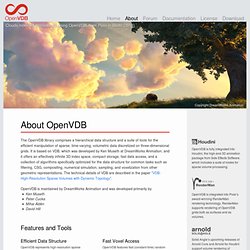
It is based on VDB, which was developed by Ken Museth at DreamWorks Animation, and it offers an effectively infinite 3D index space, compact storage, fast data access, and a collection of algorithms specifically optimized for the data structure for common tasks such as filtering, CSG, compositing, numerical simulation, sampling, and voxelization from other geometric representations. The technical details of VDB are described in the paper "VDB: High-Resolution Sparse Volumes with Dynamic Topology". OpenVDB is maintained by DreamWorks Animation and was developed primarily by Ken Museth Peter Cucka Mihai Aldén David Hill Features and Tools Efficient Data Structure Fast Voxel Access OpenVDB features fast (constant-time) random and sequential access to voxels. Conversion Tools Level Set Tools. New Project.
FluidUI.com (Fluid UI) uses cookies and saves data on our servers in order to provide the Fluid UI service.

This data is gathered in order to provide the relevant functionality for your account. The purpose of this article is to inform you what information we store, when we request it and why we need it. Your email address is used to create a unique identifier for your account when you sign up. It is also used to inform you of important updates relating to Fluid UI and your account. Your password (encrypted), IP address, and sign in history are saved to allow you sign in from different locations and to be able to ensure the security of your account. Third party services providers Fluid UI also uses a number of third party services providers in order to provide the Fluid UI service:
Vim, you complete me. Ever watch someone else type at a shell, spelling out every filename, even making typos and fixing them, very slowly?
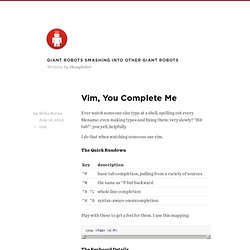
"Hit tab! ", you yell, helpfully. I do that when watching someone use vim. The Quick Rundown Play with these to get a feel for them. Smooth Voxel Terrain (Part 2) « 0 FPS. Last time we formulated the problem of isosurface extraction and discussed some general approaches at a high level.

Today, we’re going to get very specific and look at meshing in particular. For the sake of concreteness, let us suppose that we have approximated our potential field by sampling it onto a cubical grid at some fixed resolution. To get intermediate values, we’ll just interpolate between grid points using the standard trilinear interpolation. This is like a generalization of Minecraft-style voxel surfaces. About Impure. Chrome Experiments - Home. A set of top Computer Science blogs.
They are written by computer scientists and focus on computer science research;they are of consistently high quality;I regularly read them.

N.B. I have deliberately excluded blogs primarily focusing on computer science education (for another time). The Endeavour by John D. Cook (@JohnDCook) John’s blog cuts across using computing, programming and mathematics to solve real-world problems, pulling in his wide expertise as a mathematics professor, programmer, consultant, manager and statistician. Some great posts across the technical and socio-technical spectrum. Clearly this set is incomplete — please post your computer science research blog recommendations in the comments below; I’d be particularly interested in blogs covering compilers, concurrency and computer architectures.
Exponential smoothing. Exponential smoothing is a technique that can be applied to time series data, either to produce smoothed data for presentation, or to make forecasts.
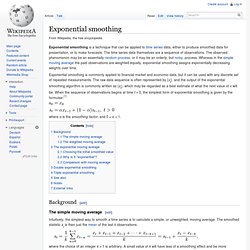
The time series data themselves are a sequence of observations. The observed phenomenon may be an essentially random process, or it may be an orderly, but noisy, process. Whereas in the simple moving average the past observations are weighted equally, exponential smoothing assigns exponentially decreasing weights over time. Light Table - a new IDE concept. You can now try Light Table out via the Light Table Playground!
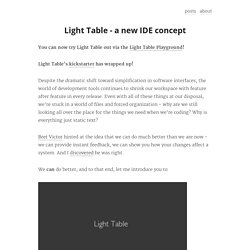
Light Table's kickstarter has wrapped up! Despite the dramatic shift toward simplification in software interfaces, the world of development tools continues to shrink our workspace with feature after feature in every release. Even with all of these things at our disposal, we're stuck in a world of files and forced organization - why are we still looking all over the place for the things we need when we're coding? Why is everything just static text? Bret Victor hinted at the idea that we can do much better than we are now - we can provide instant feedback, we can show you how your changes affect a system.